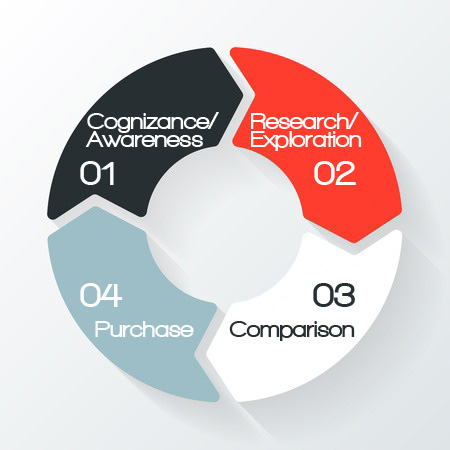Whether you’re buying a new car or a subscription to a meal kit delivery service, you’ve probably gone through some variation of the customer buying journey. You first become aware of a need or an opportunity, then you explore what options there are, weighing your options based on product benefits and expert opinions. If your product or service passed through all previous steps in the buying journey and your marketing and/or salesperson is good, the deal could be as good as done.
Scientists follow a similar buying journey, much to the surprise of some marketers. All too often, marketers of life science products or services focus too much on the benefits and technical proficiencies of their product, thinking that scientists are driven to buy things based solely on evidence. Based on their training and inquisitive nature, they may be more skeptical than the average consumer, signaling marketers to bombard scientists with facts, figures and numbers. But here, marketers fall short. It’s not just about persuading scientists with facts. Nearly 57 percent of the buying process is completed by the time a prospective customer meets with a salesperson, meaning a majority of the ‘convincing’ needs to take place earlier on in the buying journey.
In this article, learn about best practices for keeping a scientific audience engaged throughout their buying journey.
The Product
Consider the rising popularity of big data in clinical research. Many analysts are slowed down by data silos and other inefficiencies because the infrastructure is not there to harmonize disparate data. The market has now opened its doors to software companies who offer their own data management solutions for making this process quicker, simpler and more cost-effective. However, with so many different platforms competing in an overcrowded market, scientists must explore different options until they find one that fits their needs.
Recognition & Awareness
At the first stage of the sales cycle, scientists recognize a need or an opportunity. Recognition of a need is not the same as awareness of a product. Why would someone care about your product (let alone buy it) if they don’t know what gap it fills? To help scientists discover or acknowledge their own needs, marketers need to scour the issue or topic to fully understand where those needs exist. It’s important to keep in mind that marketers are trying to sell a product to serve the needs of the customer, not the company.
Therefore, a good marketer knows the subject matter inside out and can view situations from the perspective of the audience.
Consider a marketer from a software company tasked with selling a new data management platform. The marketer might spark their audience’s interest by posing a thought-provoking question or making a bold statement. For example, “Is big data slowing us down?”

Some scientists might think more patient data could reveal more clues about a patient’s disease and therefore illuminate how best to treat them, while others think “more data, more problems”. A poor IT infrastructure; lack of trained personnel; and concerns about data security, privacy, collection and storage are some of the reasons why scientists are skeptical about big data.
Because there is no right or wrong answer to the question (and scientists might be largely undecided), this question sparks enough curiosity to prompt the reader to learn more. The marketer must harness all of his or her own creativity to come up with memorable and meaningful content at this stage.
Here are some additional tips when crafting this content:
- Study your audience. Consult with professionals or attend scientific meetings to know what their take is on an issue.
- Become an expert in the subject matter. Read through the literature, learn about past and current trends or techniques and have a sense of what direction the field is heading in.
- Study the competition. Figure out who and what your product is competing against.
According to Hamid Ghanadan’s 2012 book Persuading Scientists, once scientists’ curiosity is piqued, they will go on to recognize or become aware that there is a need or an opportunity to pursue. Next, the marketers can lay out the context of the problem.
Exploration
Scientists, like most people, do not like being told what to do. They are more inclined to explore the research themselves when developing their own hypothesis. Here, it’s important for marketers to present background information in an unbiased manner, otherwise it’s no longer considered credible.
For the example above, one major issue with disparate forms of data (electronic vs. paper) is the translation of these datasets into a standardized format. Incomplete datasets could potentially jeopardize the analysis and even patient privacy. The marketer can provide scientists with a refresher on inefficiencies with data management today, particularly with handling large volumes and different forms of data. An effective strategy for communicating these pitfalls is by providing concrete examples of when studies were delayed as a result of redundancies or long periods of analysis.
The type of content presented can help marketers shape the market, ultimately guiding potential customers to think like their company and align with their company’s viewpoint: ‘Don’t you agree that current data management tools are inefficient? There has to be a better way.’
Marketers can refer to research papers describing how new data management tools are superior to traditional methods. They can draw on a third-party expert who could write about the changing landscape of clinical research and why wearable devices are rising in popularity. Or, perhaps the marketer can cite research articles or white papers in which other solutions have been implemented and where they’ve succeeded and failed.
Here are some additional tips when crafting this content:
- Provide a well-rounded background. A detailed, concise and accurate summary of a problem demonstrates expertise and reinforces credibility.
- Use a variety of content. This in-depth content should come from a variety of sources, including blogs, articles, reviews and videos to engage different audiences effectively.
- Keep the content relevant to the target audience. Again, this establishes credibility and lets the audience know that you understand their problems.
While it may appear that most of the hard work is done, scientists have not even seen the technical aspects of the product — they can still be skeptical of what’s to come.
Evaluation
At the evaluation stage, scientists seek to validate their hypothesis with a product or service. Here, marketers also want to describe the product in detail. Rather than reciting the specifications of the product, marketers should try to guide scientists to conclude that that product will bring value to their work. To do so, they must support their claims with evidence.
One significant advantage of a new data management tool could be its compatibility with multiple data management systems. This would be beneficial for investigator sites who are responsible for overseeing multiple clinical trials at once, each of which handles data differently. Again, marketers should be explicit about how their product is different from competitors and what applications it could be used for. Further, they could supplement this with case studies or testimonials from users describing the benefits of this tool.

At this stage, it’s easy for marketers to produce a laundry list of benefits for the prospective customer. But scientists have already considered hundreds of other products and might have already tested them out. For this reason, marketers should be knowledgeable about the product to field any questions scientists may have.
It’s critical to identify and focus on the greatest strength or a single distinguishing attribute of a product (which should sufficiently satisfy the scientists’ needs) and to create your competitive position around this. As described above, a platform capable of synergizing all data management systems into one could save researchers time, money and resources, and ultimately accelerate study completion times. A memorable, distinguishing feature will help scientists remember why this product is unique (and worth consideration).
Here are some additional tips when crafting this content:
- Avoid exaggeration. Stay true to the facts and the product’s capabilities.
- Be creative. Take the time to cultivate different sources for this content. Use visuals, graphs and tables to show comparisons and highlight differences
- Think “big picture”. Think about how the product can solve not just this problem, but have rippling effects across the company. Figure out what really influences a company’s buying decision (e.g. budget, training, infrastructure) and drive these points home.
In addition to having this content readily available, marketers should be prepared to connect scientists with salespeople to facilitate product demos, engage in Q&A and convince customers that they won’t regret their purchasing decision.
What Are You Waiting For?
Marketing to scientists is just like marketing to everyone else. By creating the appropriate content catered to each step of the scientist’s buying journey, marketers can avoid the scientist’s tendency for skepticism. Taking the time to do the research, be creative and experiment with new approaches will help marketers develop stronger content when marketing to scientists. While this approach may not convince every scientist to buy your product, it will sharpen your skills as an effective marketer.
Want to know more? Get in touch with our experienced marketing staff to answer any questions you may have! Leave us a comment below or contact us.












Join or login to leave a comment
JOIN LOGIN